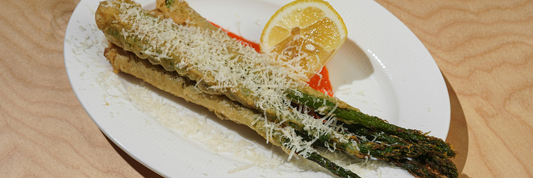Glass cutting boards are sleek, modern, and easy to clean but are they the right choice for your kitchen? While their non-porous surface offers excellent hygiene and stain resistance, there are important considerations when it comes to functionality, safety, and how they affect your knives. In this article, we’ll explore the pros and cons of glass cutting boards, helping you decide whether this stylish option truly meets your everyday kitchen needs.
What Is a Glass Cutting Board?
 A cutting board is a kitchen tool made primarily from tempered glass, which is a type of safety glass that has been treated to withstand sudden temperature changes and impact. This makes it different from traditional wooden or plastic cutting boards, both in material and functionality.
A cutting board is a kitchen tool made primarily from tempered glass, which is a type of safety glass that has been treated to withstand sudden temperature changes and impact. This makes it different from traditional wooden or plastic cutting boards, both in material and functionality.
Definition and Materials Used (Tempered Glass)
Tempered glass is known for its durability and resistance to shattering. When created, the glass undergoes a heating and cooling process that makes it stronger than regular glass. This quality is essential in a cutting board, as it allows for a smoother surface that can withstand regular chopping, slicing, and serving.
Differences vs. Wood and Plastic Cutting Boards
When comparing glass cutting boards to wooden or plastic ones, several distinctions arise:
- Maintenance: Glass boards are non-porous, meaning they do not absorb moisture or odors, in contrast to wooden boards which can develop grooves that harbor bacteria. Plastic boards can stain and often require more frequent replacements.
- Surface Quality: The smooth surface of glass provides a unique feel while cutting but can be less forgiving on knife edges compared to wood, which has a slight give.
- Environmental Impact: Glass is recyclable, while the longevity of wood depends on responsible sourcing, and plastic boards contribute to landfill waste.
Common Sizes and Designs
Glass cutting boards come in a variety of sizes and designs, making them not only functional but also decorative. Standard sizes usually range from small (12” x 12”) to large (18” x 24”), catering to different kitchen tasks. Many glass boards feature printed designs or patterns that can complement kitchen decor, adding an aesthetic element to their function.
Pros of Using Glass Cutting Boards

Aesthetically Pleasing
One of the significant highlights of glass cutting boards is their sleek, modern appearance. They can serve as a statement piece in your kitchen, showcasing beautiful designs or vibrant colors.
Non-Porous and Stain-Resistant Surface
The non-porous nature of tempered glass means that it is resistant to stains, odors, and bacteria. This quality makes it an excellent choice for preparing foods that may leave lingering smells or colors, such as garlic or beetroot.
Odor-Free and Dishwasher-Safe
Glass cutting boards are dishwasher-safe, making cleanup a breeze. Unlike wood, which can retain odors over time, glass does not absorb smells, ensuring your board remains fresh for different food preparations.
Easy to Clean and Sanitize
With simple soap and water or a quick run through the dishwasher, glass boards can be easily sanitized. This feature is crucial in maintaining a safe kitchen environment.
Cons of Glass Cutting Boards

Can Dull Knives Quickly
One downside to glass cutting boards is that they can dull knife edges more quickly than wooden boards. The hard surface provides little protection for your knives, which is an essential consideration for anyone who invests in high-quality kitchen tools.
Slippery Surface – Potential Safety Risk
The smooth surface of glass can also lead to slipping when cutting, which might pose a safety risk if not managed properly. Care should be taken to stabilize the board, especially when cutting foods that require a firm grip.
Not Ideal for Heavy Chopping or Meat Prep
Glass boards are not designed for heavy chopping or cutting through tougher foods like raw meat or dense vegetables. Using them in such ways can increase the risk of breaking or chipping.
Prone to Breaking if Dropped
Despite being durable, tempered glass is not indestructible. If dropped, there is still a risk of shattering, so care must be taken to avoid impacts that could lead to damage.
Are Glass Cutting Boards Safe to Use?
Safety Tips for Preventing Slips and Cracks
To prevent slips, consider placing a damp cloth or a non-slip mat underneath the cutting board to provide extra grip. Additionally, handle with care to avoid dropping the board, especially on hard surfaces.
When to Replace a Scratched or Chipped Board
It's essential to regularly inspect your glass cutting board for any chips or scratches. Once any damage appears, the board should be replaced, as cracks can harbor bacteria and compromise safety.
Knife Recommendations (Avoid High-End Blades)
When using glass cutting boards, consider using mid-range or stainless-steel knives designed to handle various tasks without the precision of high-end blades. Avoiding high-end knives helps extend their lifespan while maintaining the integrity of the cutting surface.
Best Uses for Glass Cutting Boards
Slicing Soft Items (Bread, Fruits, Cheese)
Glass cutting boards excel at slicing soft items, such as bread, fruits, and cheese. The smooth surface allows for clean cuts without tearing, which enhances the overall presentation of the food items.
Serving Boards and Charcuterie Displays
Beyond their cutting utility, glass boards can double as serving platters. Their aesthetic appeal makes them excellent for charcuterie displays, as they showcase a variety of cheeses, meats, and fruits beautifully.
Protecting Countertops from Hot Pans
Glass cutting boards can also serve a functional role beyond food prep. They can act as trivets, protecting kitchen countertops from hot pots or pans, which is a valuable feature in a busy kitchen environment.
How to Clean and Maintain Glass Cutting Boards

Maintaining a glass cutting board requires a few simple strategies to keep it in top shape.
Dishwasher vs. Hand-Wash Methods
- Dishwashing: Many glass cutting boards are dishwasher-safe, making them easy to clean. Place them on the top rack to avoid direct contact with heating elements. However, frequent washing in the dishwasher may lead to wear over time.
- Hand-washing: For longevity, washing by hand is ideal. Use warm water with mild soap and a soft sponge to prevent scratches. Avoid abrasive cleaners or scouring pads that could damage the surface.
Avoiding Scratches and Scuff Marks
To prevent scratches:
- Always use utensils made of silicone or wood.
- Avoid cutting hard foods that could leave marks.
- If you do notice minor scratches, use a glass cleaner for a sparkling finish.
Storage and Drying Tips
- Storage: Store your glass cutting board flat or vertically in a cabinet to avoid warping. If space allows, consider using a protective cover or mat.
- Drying: After washing, dry the board promptly using a soft cloth to prevent water spots. Make sure it is thoroughly dry before storing to prevent moisture buildup.
Glass Cutting Board vs. Other Materials
Choosing the right cutting board can significantly impact your cooking experience.
Wood: Better for Knives, More Maintenance
Wood cutting boards are gentle on knife edges and offer a natural aesthetic. However, they require regular oiling to maintain their surface and often need hand washing.
Plastic: Affordable, But Stains Easily
Plastic boards are budget-friendly and lightweight. While they can be conveniently cleaned in the dishwasher, they tend to stain over time and may harbor bacteria in grooves.
Bamboo: Eco-Friendly but Not Dishwasher-Safe
Bamboo boards are increasingly popular for their eco-friendliness. However, they are not suitable for dishwashers and can require additional care to prevent cracking.
Comparison Chart of Pros and Cons
| Material | Pros | Cons |
|---|---|---|
| Glass | Durable, hygienic, easy to clean | Can scratch knives, heavy |
| Wood | Gentle on knives, aesthetically pleasing | Higher maintenance, can warp if wet |
| Plastic | Affordable, lightweight | Stains easily, can harbor bacteria |
| Bamboo | Eco-friendly, durable | Not dishwasher-safe, can crack |
Where to Buy Glass Cutting Boards

Finding the perfect glass cutting board is easier than ever.
Online Stores and Kitchenware Retailers
Online marketplaces like Amazon or dedicated kitchenware sites offer a vast selection of glass cutting boards. Local kitchenware stores can provide hands-on experience.
Custom Printed or Decorative Options
If you’re looking for something unique, many retailers offer customizable options. This can be a fun way to add a personal touch to your kitchen.
What to Look for When Shopping
When purchasing a glass cutting board, consider:
- Non-slip backing: This feature prevents the board from sliding during use.
- Thickness: A thicker board tends to be more durable and less prone to breaking.
- Heat resistance: Ensure that the board can handle high temperatures if you plan to use it for hot pots or pans.
Conclusion
Glass cutting boards can be an excellent choice for certain cooking scenarios. They shine in non-meat cutting tasks, such as chopping vegetables or preparing cheese, thanks to their cleanliness and ease of care. If you regularly handle raw meats or prefer heavy-duty chopping, a wood or plastic board might be more suitable due to their knife-friendly surfaces.




